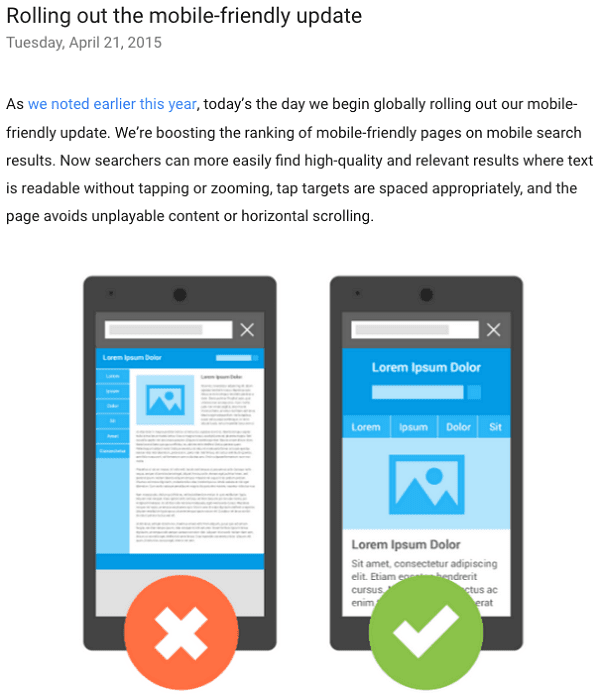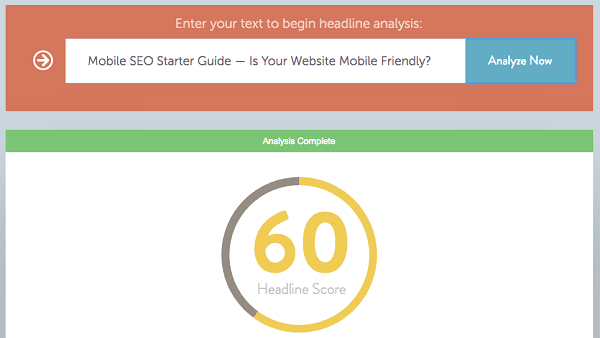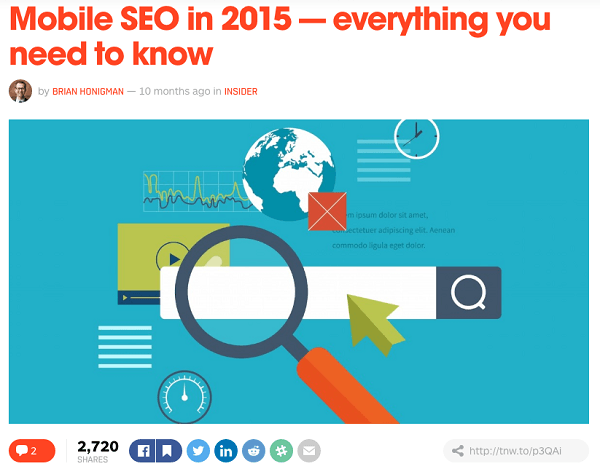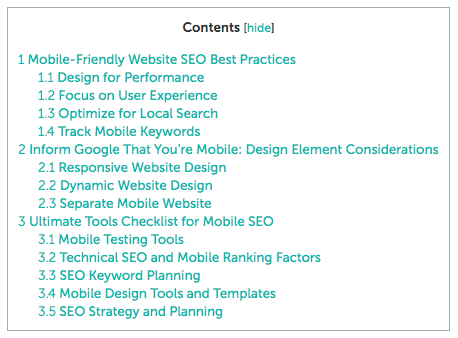When my Mobile SEO article blew up for Digital Current and landed on Google and Bing’s first page of search results, the success vindicated their content marketing strategy with the creation of high-quality, relevant content and content promotion that drew social media attention and more.
The key to a successful article, podcast, or other form of content is finding the right balance between content production and distribution.
Sounds easy on paper, but most marketers forget this.
Businesses often spend a majority of their time investing in the creation of high-quality content, but neglect to understand how that content will be distributed once published.
If your team developed the most useful piece of content, but no one sees it, then the quality doesn’t matter.
The opposite is true as well, since driving lots of visibility to low-quality or irrelevant content won’t drive any results either.
I’ve compiled a case study based on the performance of my recent article, “Mobile SEO Starter Guide — Is Your Website Mobile Friendly?” to illustrate how to create and distribute an effective article for your blog.
This case study will explore how this piece was written, promoted, and updated after it began to gain traction, as well as tips I used throughout the process. The goal is to apply our findings to your unique approach to your content marketing strategy to achieve your goals.
Article Performance Summary
Let’s review how this article performed on the Digital Current blog. The article was first published on May 19, 2015. In the year since publication, the article has generated the following results:
- 1,500+ shares on social media, primarily on Facebook, LinkedIn, Twitter, and Google+. (Source: BuzzSumo)
- 80+ backlinks from 34 referring domains on major industry sites like the Next Web, Inspired Mag, and Ninja Outreach. (Source: Ahrefs + Moz)
- 10+ keywords ranked on the first page in Google search results like “mobile seo,” “mobile seo agency,” “seo for mobile websites,” “mobile search engine optimization,” and 180+ other keywords ranked. (Source: SEMrush)
- 3,500+ page views and average time on page is four minutes and 22 seconds. (Source: Google Analytics)
Stage 1: Content Creation
The content marketing strategy goal from the start was to create a high-quality article on a subject that business owners, brand managers, marketing executives, and other Digital Current prospects could learn from.
When it came to choosing a topic, it needed to be an area that related to Digital Current’s SEO services and aligned with the ongoing interests of their intended audience.
Below is my process for writing this article to ensure it drove the most amount of visibility possible.
Tip #1: Newsjacking
At the beginning, the idea for the piece came about as a reaction to the news shared from Google in April 2015 that mobile-friendly web pages would finally be prioritized across mobile searches.
Since this was relevant news for the SEO industry and our audience, developing a resource around this timely topic could help bring our perspective into a trending conversation.

By newsjacking, or injecting our ideas into a breaking news story, we were able to extend the life of the article and generate interest in the piece as soon as it was published.
Since the subject of mobile SEO is relatively new compared to other marketing disciplines, it was easier to create an original article that directly competed with similar pieces of content on the same subject.
The less competition there is on a particular topic, the easier it is to have your content on the subject stand out, which helped drive visibility to the article.
Tip #2: Headline Choice
With a topic area in mind, I brainstormed some different headline variations for this guide on explaining how businesses could adapt to mobile SEO due to the recent news.
Choosing an engaging headline is particularly important as it helps readers decide if they are going to click on an article in search or social, as well as if they will share it more readily across social media.
After developing a few headline options that were focused on relevant keywords, I added each option to CoSchedule’s Headline Analyzer tool to test how effective each one was.

The tool provides a score from 0 to 100 on your overall headline quality and rates its ability to spur social shares, increased traffic and SEO value.
From testing a few options, I combined together two different headlines to decide upon “Mobile SEO Starter Guide — Is Your Website Mobile Friendly?”
Tip #3: The Skyscraper Method
After choosing a topic and a headline, I considered the various keywords to focus this article on to ensure it had the best chance at ranking in the search engines.
I reviewed the existing search results for my list of keywords to understand what other articles are ranked highly and also address the same subject.
Using the “Skyscraper Technique,” a strategy for building upon a similar piece of content with a new angle, I identified existing blog posts on the subject that could be improved upon with additional information, better design, updated statistics, and more.
Applying this technique allows your content to build upon the demand in the search engines and potentially rank higher than existing content if you’re able to provide more value with your approach.
Tip #4: Lengthy Word Count
One way I was able to provide more value with this article using the Skyscraper Technique was by covering the subject in more depth than other resources on the topic.
The word count for this article was approximately 3,000 words, which was a purposeful choice as it allowed more space to cover the subject extensively from a few angles.
Research from Search Engine Land found that content over 2,000 words often generates more backlinks, ranks higher in the search engines, and increases engagement on social media.
Not all content should be long form, but if there’s enough value to discuss on a topic then consider going beyond 1,000 words to create a worthwhile resource that stands out.
Tip #5: Section Headers
The headers for each section of the article were also optimized to focus on relevant keywords and logically organized the piece for readers.
Including a variety of specific headers for each sub-section of the piece helped to better optimize it for ranking in the search engines.

The use of H1, H2, H3, and H4 HTML tags throughout your section headers can help inform the search engines as to what your article is actually about.
Tip #6: Internal Linking Infrastructure
An additional way I optimized the piece for SEO was by linking to other relevant articles from the Digital Current blog within the article itself.
Choose a few words within a sentence that might be a keyword you’re optimizing for in another article on your blog and link to the other article from that anchor text. Here’s an example:
“Perhaps some of the panic and frenzy around Google’s algorithm tweak, which some are claiming as ‘Mobilegeddon,’ comes from a general misunderstanding as to how SEO works, particularly as it relates in a mobile environment.”
The goal with this step is to drive readers to other relevant pieces on your blog that are related to the subject being discussed in the article they are reading. By linking to other content on your site you support the link architecture of the website and distribute page authority and ranking throughout the blog.
Never link to a resource for the sake of linking to it, but instead find pieces on your own property that feature a related topic to what’s being covered in the original article and link to them.
Tip #7: External Linking to Relevant Sources
Links to third-party websites were also included to give readers access to additional information on topics related to what’s being discussed in the piece.
I linked to relevant blogs that cover SEO like KISSmetrics, Quicksprout, Content Marketing Institute, Search Engine Land, and others.
These links were less frequently included than links to internal content, but their inclusion gave readers a variety of options on what to read. This also gave them a chance to learn about a particular topic from different websites and explore recommendations on related topics.
Google and other search engines also value content that links to credible third-party sources. Linking to other websites offers a better experience for readers to continue to access useful information and also provides the search engines with context about the authority of content.
Stage 2: Content Promotion
At this point, the article is written and published on the Digital Current blog and we’re ready to move on to the next part of our content marketing strategy: promotion. The following are the steps taken to promote the piece to as many readers as possible after publishing.
Tip #1: Paid Social Advertising
Beyond simply sharing the article on Digital Current’s Facebook, Twitter, and LinkedIn accounts, the piece was also promoted on Facebook to increase visibility right after it was published.
Paid advertising on social media, specifically Facebook, is a low-cost way to target the right audience and drive them to perform a particular action.
In this case, the Facebook ads drove attention to the article by getting relevant Facebook users to visit the blog and read the piece.
Secondary to driving traffic to the article, the ads were also meant to spur interaction and conversation about the article on Facebook as well.
Experiment with paid ads on social media to see which mix of networks drives the best results and are a cost-effective approach to reaching your goals with content.
Tip #2: Author’s Social Profile
As a writer for Digital Current and other clients, I’ve built an audience due to my experience writing about marketing, business, and technology over the last six years.
After writing this piece, I shared the article with my followers across social media and my email newsletter to encourage more people to read it.
Whether you’re using a freelance writer or a staff writer, encourage them to actively share their articles from their own social media profiles, as they continue to develop their network online.
When choosing freelance talent to contribute to your blog, review their social media presence. If your blog authors have their own engaged following, they can help increase the visibility of the content they’re developing on behalf of your company.
Tip #3: Content Syndication
Two months after publishing, the article was syndicated on the tech blog The Next Web.
Through my relationship with the publication as a contributing writer, I pitched the piece to my editor to see if they were interested in republishing it on their site.
Syndication is a simple way to reach a new audience with your content by supplying another website with your content for free to republish with attribution to the original source.

The syndicated piece links to the original article to clarify who the publisher was and it also includes all the links to related Digital Current content and third-party sources.
The process of syndication helps drive additional links to your original article, more readers from another audience, increased sharing on social media, and growing your brand awareness.
Stage 3: Content Refresh
The article began to gain traction not long after publishing and promoting it, which led us to update the piece a few months after it was initially published.
Refreshing previously published content helps improve its ongoing performance by correcting any errors, adding more depth to a topic, and updating any information that is no longer accurate.
These are the steps that were taken to refresh the piece for accuracy and make it a more engaging article overall.
Tip #1: Adding an Outline
The word count for this article was lengthy to improve its performance in the search engines and ensure it is a useful resource on the subject of mobile SEO.
However, the length of the piece may have made it difficult for some readers to find the specific section or recommendation that is the most pertinent to their needs.
The addition of a table of contents at the beginning of the piece helped to organize it and make finding a certain part of the article much easier.

Consider adding elements to your written content while you’re writing it or after it’s been published in order to improve a reader’s experience digesting your article.
Tip #2: Additional Relevant Links Added
Two sections of text titled as “More Resources & Tools” were also added after the piece was published to call attention to other useful articles on the topics discussed.
These sections of text highlight the headlines of two to three related articles from on the Digital Current blog and third-party websites with a brief description of what each piece is about.
The goal of adding these sections is to continue to link to valuable content to associate the piece with other relevant sources on the subject for SEO purposes and to improve the article for readers.
Tip #3: Custom Visuals Designed for Each Section
Initially the article only had a header image and a few others included throughout the piece, which was a missed opportunity to make the article far more engaging from a visual standpoint.
After publishing, Digital Current designed custom visuals to use for the header of the article and to be included within each section of the piece.
The custom visuals included in each section helped break up the piece for readers, solidify concepts explained in the text, draw attention to important data points, and were used to promote the piece visually on social media.
Consider adding videos, images, GIFs, Slideshares, and other forms of visual content to your articles to increase the likelihood that it will resonate with your audience.
Tip #4 – Update Inaccurate Information
To maintain the quality of the article over time, we updated aspects of the text as they were no longer accurate, even if they were at the time of publishing.
Reviewing past articles and updating them for freshness and accuracy will ensure the long-term performance of your content.
We recommend that you do a monthly or bi-monthly audit of your existing written content to ensure it’s updated with the latest information.
Applying This Process
To apply this three-stage approach to your content marketing strategy with written content, start by understanding what your goals are and what resources are available to allocate to content.
Ask yourself: Is your business trying to increase brand awareness? Are you looking to drive leads directly from your content? Is your content meant to answer the customer service requests of your clients?
Remember that your company likely won’t see overnight success with content marketing on your blog, as it’s more of an ongoing effort driven by a combination of the above tips and others to consistently provide value.
Encouraging social sharing, generating backlinks, and driving qualified traffic to your website with content is a long-term commitment that requires a special balance of creating engaging content and promoting this content wherever your audience is active.
What challenges are you facing with your content marketing strategy? Which of the above tips have you tried before to strike a better balance between content production and distribution? Share your thoughts with us over on Twitter @DigitalCurrent.


